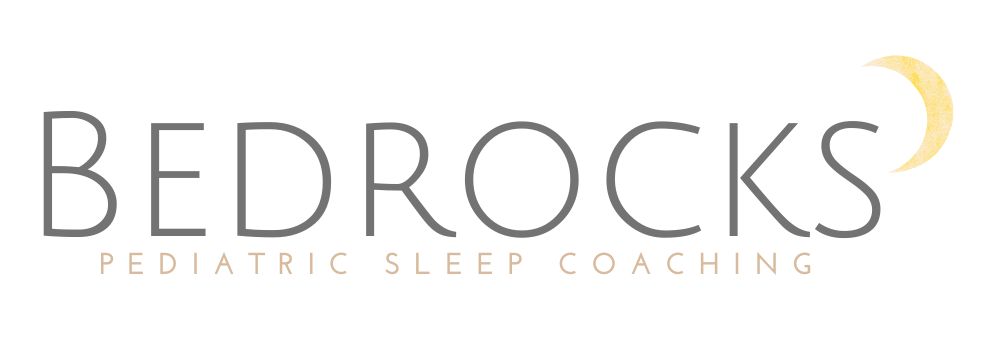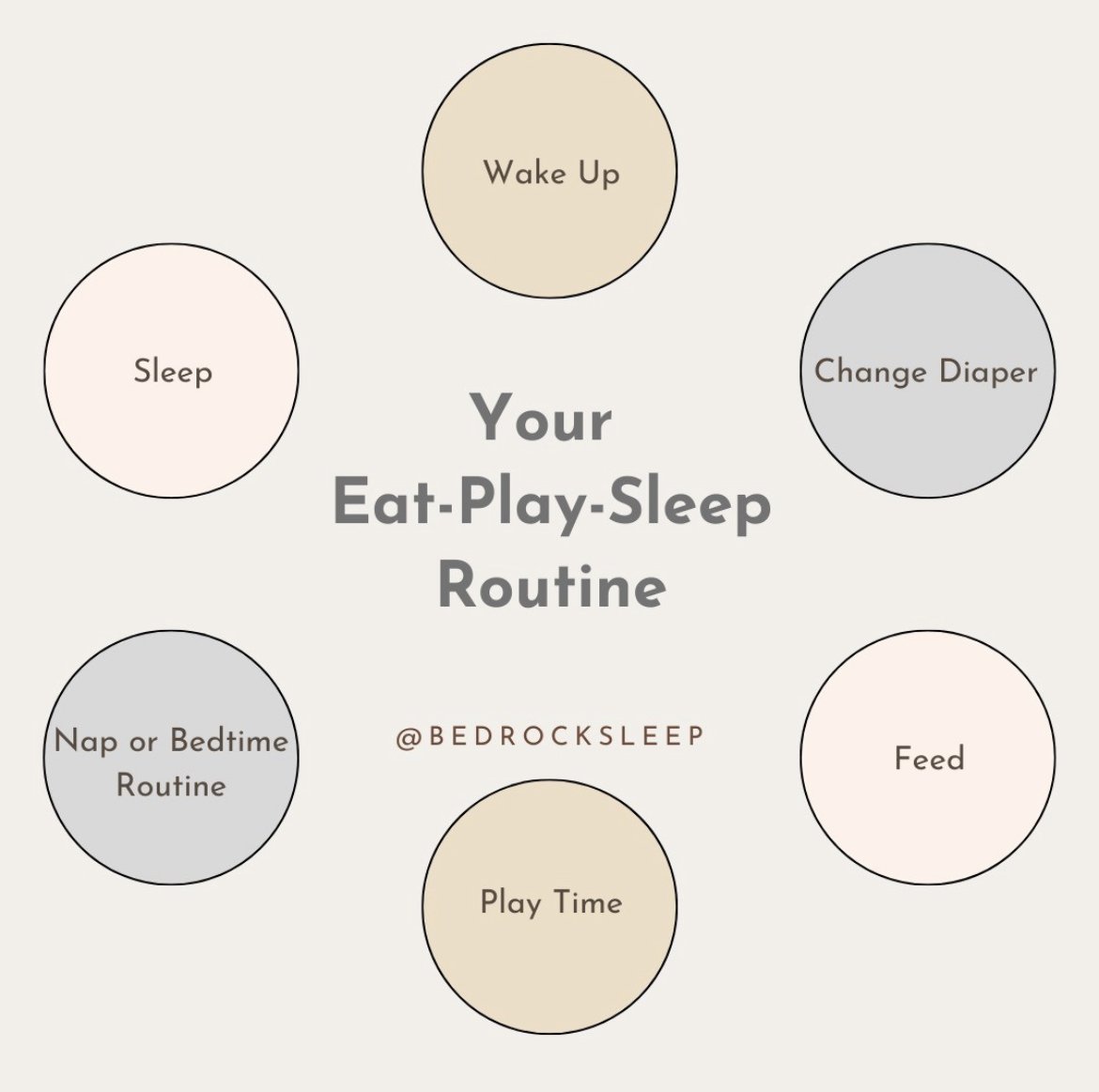The Benefits of following an Eat-Play-Sleep Routine.
An Eat-Play-Sleep routine is a way of loosely organizing your baby’s eating and sleeping during the day. You feed baby upon waking, followed by an age-appropriate period of awake time, and then put them down for a nap. This cycle is repeated over and over throughout the day until bedtime!
The idea of an Eat-Play-Sleep routine comes from the book “On Becoming Babywise” by Robert Bucknam, M.D. and Gary Ezzo, M.A. In Chapter 2 of the book, they discuss different feeding philosophies and how a parent-led approach to feeding, like Eat-Play-Sleep, leads to the outcomes for your child’s overall well-being (and your own too!)
Here’s a quick overview of the 3 different feeding philosophies talked about in Babywise:
Child-led feeding or “feeding on demand” means that feeding times are entirely dictated by baby’s hunger cues. If they show a hunger cue, they they’re hungry, you feed them, regardless of how much time has passed since their last feeding.
Clock-based feeding means that the clock determines when baby is feed, usually in pre-determined intervals. Hunger cues are not a factor because feeding times are predictable. The clock thinks for the parent.
Parent-led feeding means that both hunger cues and the clock are factors when assessing whether or not it is time for a feed.
Let’s talk about each feeding philosophy briefly, and I promise you, this all comes back to sleep!
The problem with a “feeding on demand” philosophy is that it relies solely on hunger cues which can be wildly misleading. In fact, hunger cues and tired cues often look the same! All too often, this leads to a parent feeding a baby who actually needs to sleep which results in overfeeding and overtiredness.
Feeding on demand is also the #1 reason that moms decide to stop breastfeeding. They become too exhausted because it is not sustainable.
While a 100% child-led approach has it’s issues, so does a clock-based approach. The clock may be more reliable than hunger cues, but now we’ve swung too far in the other direction. You run the risk of ignoring legitimate hunger cues. Obviously, we don’t want that to happen.
A parent-led approach, like Eat-Play-Sleep, is a moderate approach that balances out the more extreme child-led and clock-based approaches.
After all, isn’t that our job as parents? To lead and guide our children? I think so.
Leaving it up to your little baby to tell you when they should eat and when they should sleep is a recipe for disaster. As parents, our little ones rely on us for guidance in helping them settle into a healthy pattern of eating and sleeping.
Following an Eat-Play-Sleep routine promotes good sleep by promoting full feeds.
I’m sure we’ve all experienced a sleepy newborn who falls asleep on the breast or bottle while taking a feed. I call this the “snack and snooze” and while you’ll never avoid it completely in those very early days, you can absolutely move away from it with practice and help baby settle into a predictable rhythm of sleeping and eating.
The benefit of feeding baby upon waking is that they are going to take a full feed, instead of getting drowsy, because they just slept! Then once they are fed, you have your time for activity. For a newborn, that awake time will be very short, only 45-60 minutes. As baby gets older, the wake window will increase.
As the wake window comes to a close, you get baby ready for sleep with a simple nap routine. This could be going into a darker room, swaddling baby (up until 8 weeks) or putting on a sleep sack, reading a book or singing a song, turning on white noise, and laying baby down in their bassinet or crib awake.
Now watch and see what happens.
Baby may be able to drift off to sleep with little to no support from you. Other times they may need more support, such as a hand on their chest and some shushing, or even being picked up and rocked.
The idea is to start practicing independent sleep and giving them some space. This is not sleep training but it’s an excellent way to prepare for it! The more you practice, the more progress you will see!
The important thing is that baby is not being fed to sleep. This is the hardest sleep association to break. That is why it’s best not to create the association in the first place!
If you’re reading this too late and you already have a feed to sleep association on your hands, that’s what I’m here for. To help you teach baby how to fall asleep without their feeding “prop”, or other external props, in a gradual, thoughtful and compassionate way. My full support Bedrocks Baby package is ideal for any parent in this situation who is feeling helpless!
I want to wrap up this blog post with an excerpt from the Babywise book about how a parent-led approach to feeding facilitates the parent-child attachment:
“This is achieved by creating an orderly environment where growth and development are optimized. The fact that a baby’s biological and neurological needs are rhythmical merging with Baby’s natural capacities, means nothing is hindering the upward progress toward comprehensive attachment. “Comprehensive” refers to the total spectrum of growth and development as measured by an infant’s attainment of his or her developmental capacities. Infants who fail to attain these basic capacities within the first six months of life often become under-achievers in other developmental prerequisites leading to healthy relational attachment.
Babies are born with seven capacities, that when met, provide objective markers confirming comprehensive attachment is being achieved. The markers include babies who 1) synchronize their feed-wake-sleep cycles into predictable patterns; 2) can fall asleep without a rocking or nursing prop; 3) sleep through the night 8-10 consecutive hours; 4) have a predictable nap routine; 5) have content wake-times and are adapt to self-play; 6) are able to self-soothe; 7) find comfort with other caregivers, specifically fathers, siblings or grandparents.
The progressive achievement of each attachment marker in the first six months of baby’s life, are leading indicators that baby is not in a constant state of stress or anxiousness".”
This is why I so firmly believe in following an Eat-Play-Sleep routine from day one! It is the best way to promote baby’s overall health and wellbeing, which in turn promotes the wellbeing of the entire family.


